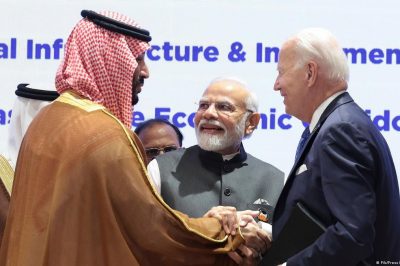The G20 meeting in New Delhi in September 2023 opened with the announcement of the India-Middle East-Europe Economic Corridor (IMEC). Prime Minister Narendra Modi inaugurated the India-Middle East-Europe mega economic corridor on Saturday during the G20 summit. World leaders from Saudi Arabia, the European Union, India, the United Arab Emirates, France, Germany, Italy, and the United States signed a Memorandum of Understanding to collaborate on the development of an India-Middle East-Europe Economic Corridor during the G20 summit in New Delhi.
The IMEC is a massive infrastructure project that could have a significant direct and indirect impact on China. It has the potential to erode China’s regional power as other countries, notably India and European nations, develop a greater presence. This may result in a more multipolar regional dynamic.
The IMEC countries represent 40% of the world’s population and roughly 50% of the global economy. The corridor will promote supply chain security, employment development, and trade facilitation and accessibility. This corridor will rely on the UAE and Saudi Arabia’s seaports, roads, and logistics hubs, highlighting the importance of these Gulf Arab states as vital centers in global trade routes.
Also Read: Pakistan’s Caretaker Prime Minister Discusses CPEC Progress
The IMEC will include railway, ship-to-rail networks, and road transport routes covering two corridors: the east corridor connecting India to the Gulf and the northern corridor connecting the Gulf to Europe. The railway will offer a reliable and cost-effective cross-border ship-to-rail transit network. The project focuses on two 4,800-kilometer ship-to-rail transit lanes connecting India to Europe via the Arabian Gulf, providing consumers and manufacturers in the UAE, Saudi Arabia, Jordan, and Israel greater access. UAE and Saudi Arabia are both major supporters of IMEC both are the natural territorial bridge between Europe and India. Muhammad Bin Salman Saudi Crown Prince committed to investing $20 billion in the project.
Through this commercial corridor, authorities in Abu Dhabi and Riyadh hope to balance their networks in Europe and North America with those in China and other East and Global South nations. The UAE and Saudi Arabia are using IMEC as a major inter-regional communication center to diversify their economies away from hydrocarbons. In comparison with prior trading efforts, the IMEC has a bigger coalition of regional and non-regional actors. In addition, it prioritizes infrastructure beyond trade policy to promote inter- and intra-regional trade.
The Corridor aims to enhance trade efficiency between Europe and Asia, with UAE and Saudi Arabia as key hubs, thereby strengthening their international trade importance. It is also a project of major developed economies to build an infrastructure of significant worth in low- and middle-income countries.
Greater connectivity with the Middle East, particularly the Gulf region, and projecting influence into the Gulf are critical components of India’s efforts to establish itself as a major player worldwide. As a major trading and security partner, a source of energy resources, investments, and remittances, and a destination for Indian workers, the Gulf is strategically important to India. India is expected to benefit considerably from the project since it will be at the crossroads of trade flows from Southeast Asia to the Middle East and Europe, bringing geopolitical and economic advantages.
IMEC aims to counter China’s increasing influence. It is a part of the great power competition between the United States and China. The U.S. aims to counter China’s influence in the Middle Eastern region and aims to bring GCC states closer to the West’s sphere of influence. Certain geopolitical dynamics surrounding IMEC and New Delhi’s incentives to participate in this transcontinental corridor are influenced by tensions between India and China. The IMEC will enable Modi’s government to leverage India’s growing interconnectedness with Gulf Arab states, including Saudi Arabia and the UAE, to counter China’s increasing influence in the Middle East.
IMEC is considered a Western response to China’s Belt and Road Initiative (BRI). China Proposed BRI in 2013. China has loaned about $1 trillion to developing nations for infrastructure projects such as power plants, highways, airports, and telecommunication networks, with over 3,000 projects scheduled for completion by 2049. Some IMEC signatories are also BRI members, including Saudi Arabia, and the United Arab Emirates. On the other hand, Italy is no longer formally part of the Belt and Road Initiative (BRI). Several countries accuse China of acquiring strategic influence without taking into account local demands and of inflicting environmental damage through its programs. However, there are indications that China is slowing down on BRI due to its flagging economy.
IMEC is viewed as a challenge to China’s Belt and Road Initiative (BRI) by major US allies in the Middle East, Europe, and India. While IMEC provides economic benefits to India, the United States sees it as a way to fight China’s geo-economic might, especially as China has surpassed the United States as the EU’s largest trade partner.
The alternative approach proposed by IMEC lessens China’s regional connectivity and infrastructure monopoly, possibly attracting nations wary of relying too much on the Chinese economy and perhaps changing regional power dynamics. India’s engagement in IMEC represents a significant shift in its regional posture, as it seeks to offset China’s strong presence in the Middle East through economic and political influence. IMEC places India in direct rivalry with China for Middle Eastern influence. This competition may manifest itself in a variety of ways, including competing for economic partnerships and infrastructure projects, as well as obtaining political alliances and diplomatic ties.
The maritime route focus of IMEC might offset China’s Belt and Road Initiative’s land-based infrastructure, potentially attracting diversity and lowering dependency on Chinese-built infrastructure. IMEC, a global alliance comprised of the United States, the European Union, and Israel, seeks to challenge China’s influence, perhaps encouraging a more multipolar regional power structure.
The India-Middle East-Europe Economic Corridor (IMEC) aims to compete with China’s Belt and Road Initiative (BRI) by providing transparent finance, environmental sustainability, and strengthened relationships. Its emphasis on regions where the BRI has been criticized, India’s reservations about CPEC, and support from the US and EU all indicate a geopolitical aim to restrict China’s influence and give developing nations options other than the BRI’s debt-laden infrastructure projects. The rise of IMEC, a counterbalance to the Belt and Road Initiative, and India’s strategic presence in the Middle East threaten China’s dominance, potentially transforming the Middle Eastern and European economic and political landscapes.

The writer is a graduate of International Relations from the International Islamic University Islamabad. Her areas of interest are Russia and China’s relations with European Countries.









2 responses
IMEC is expected to compete BRI but it will take time to be parallel to China. Although USA is feared about maintaining it’s hegemony in middle east region so it’s kind of step to attain stability and grip over region by using India.
IMEC is trying to on arm to arm with BRI but it will take time to be parallel to China. Although USA is feared about maintaining it’s hegemony in middle east region so it’s kind of step to attain stability and grip over region by using India.